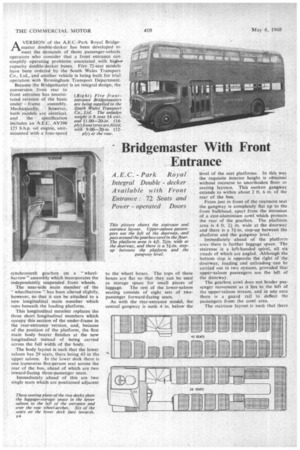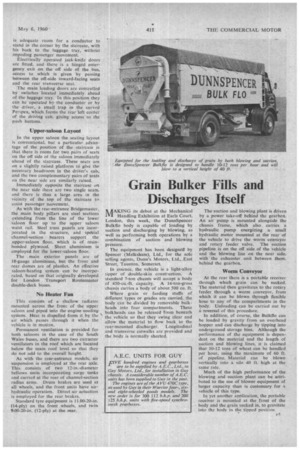' Bridgemaster With Front Entrance
Page 98

Page 99

If you've noticed an error in this article please click here to report it so we can fix it.
A.E.C.Park Royal Integral Double decker Available with Front Entrance: 72 Seats and Power operated Doors
AVERSION of the A.E.C.-Park Royal Bridgemaster double-decker has been developed to meet the demands of those passenger-vehicle operators who consider that a front entrance can simplify operating problems associated with hicapacity double-decker buses, Five 72-seat models have been ordered by the .South Wales Transport Co., Ltd., and another vehicle is being built for trial operation with Birmingham Transport Department.
Mechanically, however, both models are identical, and the specification includes an AEC. AV590 125 b.h.p. oil engine, unitMounted With a four-speed synchromesh gearbox on a "wheelbarrow" assembly which incorporates the independentlyt suspended front wheels.
The near-side main member of the " wheelbarrow " has been altered slightly, however, so that it can be attached to a new longitudinal main, member which runs beneath the loading platform.
This longitudinal member replaces the three short longitudinal members which occupy this section of the under-frame in the rear-entrance version, and, because of the position of the platform, the first main body bearer finishes at the new longitudinal instead of being carried across the full width of the body.
The body layout is such that the lower saloon has 29 scats, there being 43 in the upper saloon. In the lower deck there is one transverse five-person seat across the rear of the bus, ahead of which are two inward-facing three-passenger seats.
Immediately ahead of this are two single seats which are positioned adjacent to the wheel boxes. The tops of these boxes are flat so that they can be used as storage space for small pieces of luggage. The rest of the lower-saloon seating consists of eight sets of twopassenger forward-facing seats.
As with the fear-entrance model, the central gangway is sunk 4 in. below the
level of the scat platforms. In this way the requisite interior height is obtained without recourse to unorthodox floor or seating layouts. This sunken gangway extends to within about 2 ft. 6 in. of the rear of the bus.
From just in front of the rearmost seat the gangway is completely flat up to the front bulkhead, apart from the intrusion of a cast-aluminium cowl which protects the rear of the gearbox. The platform area is 4 ft, 2-1 in. wide at the doorway and there is a 51-in. step-up between the. platform and the gangway level.
Immediately ahead of the platform -area there is further luggage space. The staircase is a left-handed spiral, all sixtreads Of which are angled. Although the bottom step is opposite the right of the doorway, loading and unloading can be carried out in two streams, provided that upper-saloon passengers use the left of the doorway.
The gearbox cowl does not hinder passenger movement as it lies to the left of the upper-saloon stream, and in any case there is a guard rail to deflect the passengers from the cowl area.
The staircase layout is such that there is adequate room for a conductor to stand in the corner by the staircase, with his back to the luggage tray, without impeding passenger movement.
Electrically operated jack-knife doors are fitted, and there is a hinged emergency exit on the off side of the bus, access to which is given by passing between the off-side inward-facing seats and the rear transverse seat.
The main loading doors are controlled by switches located immediately: ahead of the luggage tray. In this position they can be operated by the conductor or, by the driver, a small trap in the curved Perspex, which forms the rear left corner of the driving cab, giving access to the push buttons.
Upper-saloon Layout
In the upper saloon the seating layout is conventional, but a particular advantage of the position of the staircase is that there is room for two pairs of seats on the off side of the saloon immediately ahead of the staircase. These seats are on a slightly raised platform to give the necessary headroom in the driver's cab, and the two complementary pairs of seats on the near side are similarly raised.
Immediately opposite the staircase on the near side there are two single seats. and there is thus a large. area in the vicinity of the top of the staircase to assist passenger movement.
As with the rear-entrance Bridgemasier. the main body pillars are steel sections extending from the line of the lower saloon floor up to the upper saloon waist rail. Steel truss panels are incorporated in the structure, and special channel-section bearers support the upper-saloon floor, which is of resinbonded plywood. Sheet aluminium 18 employed for the lower-saloon floor.
The main exterior panels are of 18-gauge aluminium, but the front and rear domes are of plastics. An effective saloon-heating system can be incorporated, based on that originally developed for London Transport Routernaster double-deck buses.
No Heater Fan
This consists of a shallow radiator mounted across the front of the upper saloon and piped into the engine cooling system. Heat is dispelled from it.by the air which passes through it when the vehicle is in motion.
Permanent ventilation is provided for both saloons in the case of the South Wales buses, and there are two extractor ventilators in the roof which are located below the main roof level so that they do not add to the overall height As with the rear-entrance models, air suspension is employed at the rear axle.
This consists of iw-o 12-in.-diameter
bellows units incorpOrating surge tanks and carried at the rear of channel-section radius arms. Drum brakes are used at all wheels, and the front units have airhydraulic operation. Direct air actuation is employed for the rear brakes.
Standard tyre equipment is 11.00-20-in. (14-ply) on the front wheels, and twin 9.00-20-in. (12-ply) at thereat.




































































































































































































































































